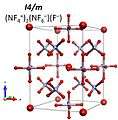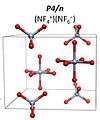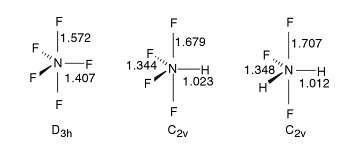Nitrogen pentafluoride
Nitrogen pentafluoride is a theoretical compound of nitrogen and fluorine that is hypothesized to exist based on the existence of the pentafluorides of the atoms below nitrogen in the periodic table, such as phosphorus pentafluoride. Theoretical models of the nitrogen pentafluoride (NF5) molecule are either a trigonal bipyramidal covalently bound molecule with symmetry group D3h, or NF+
4F−, which would be an ionic solid. Also, a related compound NH+
4F− is known.[2]
| Names | |
|---|---|
| IUPAC name
Nitrogen pentafluoride | |
| Identifiers | |
3D model (JSmol) |
|
| |
| |
| Properties | |
| NF5 | |
| Molar mass | 108.999 g/mol |
| Structure | |
| trigonal bipyramidal | |
| 0 D | |
| Related compounds | |
Other cations |
Phosphorus pentafluoride Arsenic pentafluoride Antimony pentafluoride Bismuth pentafluoride |
Related compounds |
Nitrogen trifluoride |
Except where otherwise noted, data are given for materials in their standard state (at 25 °C [77 °F], 100 kPa). | |
| Infobox references | |
Ionic solid
In 1966, W. E. Tolberg first synthesized a five-valent nitrogen compound of nitrogen and fluorine when tetrafluoroammonium compounds, tetrafluoroammonium hexafluoroantimonate NF4SbF6 and tetrafluoroammonium hexafluoroarsenate NF4AsF6 were made.[3] In 1971 C. T. Goetschel announced the preparation of NF4BF4 and also produced a white solid assumed to be tetrafluoroammonium fluoride (NF+
4F−). This was made by treating nitrogen trifluoride and fluorine with 3 MeV electron radiation at 77 K. It decomposed above 143 K back into those ingredients.[3] Theoretical studies also show the ionic compound is very likely to decompose to nitrogen trifluoride and fluorine gas.[4]
Karl O. Christe synthesised bis(tetrafluoroammonium) hexafluoronickelate (NF4)2NiF6.[5] He also prepared compounds with manganese, a fluorouranate, a perchlorate, a fluorosulfate and N2F+
3 salts.[6] Christe attempted to make NF4F by metathesis of NF4SbF6 with CsF in HF solvent at 20 °C. However, a variant, tetrafluoroammonium bifluoride (NF4HF2·nHF), was produced. At room temperature it was a milky liquid, but when cooled, turned pasty. At −45 °C it had the form of a white solid. When reheated it frothed, giving off F2, HF and NF3 as gases.[6] This has CAS number 71485-49-9.[7]
I. J. Solomon believed that nitrogen pentafluoride was produced by the thermal decomposition of NF4AsF6, but experimental results were not reproduced.[8]
Dominik Kurzydłowski and Patryk Zaleski-Ejgierd predict that a mixture of fluorine and nitrogen trifluoride under pressure between 10 and 33 GPa forms NF+
4F− with space group R3m. This is a high-pressure oxidation. Over 33 GPa it will form a stable ionic compound with formula (NF+
4)2NF−
6F– with space group I4/m. Over 151 GPa this is predicted to transform to NF+
4NF−
6 with space group P4/n.[9] A NF5 molecular compound is not stable under any pressure conditions.
 NF4+F− R3m structure
NF4+F− R3m structure (NF4+)2NF6−F− I4/m structure
(NF4+)2NF6−F− I4/m structure NF4+NF6− P4/n structure
NF4+NF6− P4/n structure
Molecule

For a NF5 molecule to form, five fluorine atoms have to be arranged around a nitrogen atom. There is insufficient space to do this in the most compact way, so that bond lengths are forced to be longer. Calculations show that the NF5 molecule is thermodynamically favourably inclined to form NF4 and F radicals with energy 36 kJ/mol and a transition barrier around 67–84 kJ/mol.[10] Nitrogen pentafluoride also violates the octet rule in which compounds with eight outer shell electrons are particularly stable.[2]
References
- Jäger, Susanne; von Jouanne, Jörn; Keller-Rudek, Hannelore; Koschel, Dieter; Kuhn, Peter; Merlet, Peter; Rupecht, Sigrid; Vanecek, Hans; Wagner, Joachim (1986). F Fluorine: Compounds with Oxygen and Nitrogen. Gmelin Handbook of Inorganic Chemistry. 4. Berlin: Springer. p. 163. doi:10.1007/978-3-662-06339-2. ISBN 978-3-662-06341-5. Retrieved 29 August 2015.
- Lewars, Errol G. (3 November 2008). "Nitrogen Pentafluoride and Related Compounds". Modeling marvels: computational anticipation of novel molecules. Springer. pp. 53–67. doi:10.1007/978-1-4020-6973-4_4. ISBN 978-1-4020-6972-7.
- Goetschel, C. T.; V. A. Campanile; R. M. Curtis; K. R. Loos; C. D. Wagner; J. N. Wilson (July 1972). "Preparation and properties of perfluoroammonium tetrafluoroborate, NF+
4BF−
4, and possible synthesis of nitrogen pentafluoride". Inorganic Chemistry. 11 (7): 1696–1701. doi:10.1021/ic50113a051. - Christe, Karl O.; William W. Wilson (December 1992). "Nitrogen pentafluoride: covalent NF5 versus ionic NF4+F− and studies on the instability of the latter". Journal of the American Chemical Society. 114 (25): 9934–9936. doi:10.1021/ja00051a027.
- Christe, Karl O. (September 1977). "Synthesis and characterization of bis(tetrafluoroammonium) hexafluoronickelate". Inorganic Chemistry. 16 (9): 2238–2241. doi:10.1021/ic50175a017.
- Christe, Karl O. (23 May 1980). "Research Studies in NF4+ Salts" (PDF). Rockwell. Retrieved 23 February 2012.
- Tetrafluoroammonium bifluoride
- Christe, Karl O.; William W. Wilson; Gary J. Schrobilgen; Raman V. Chirakal; George A. Olah (March 1998). "On the existence of pentacoordinated nitrogen". Inorganic Chemistry. 27 (5): 789–790. doi:10.1021/ic00278a009.
- Kurzydłowski, Dominik; Zaleski-Ejgierd, Patryk (3 November 2016). "Hexacoordinated nitrogen(V) stabilized by high pressure". Scientific Reports. 6: 36049. Bibcode:2016NatSR...636049K. doi:10.1038/srep36049. PMC 5093683. PMID 27808104.

- Holger F. Bettinger, Paul v. R. Schleyer, and Henry F. Schaefer III (27 October 1998). "NF5 — Viable or Not?". Journal of the American Chemical Society. 120 (44): 11439–11448. doi:10.1021/ja9813921.CS1 maint: uses authors parameter (link)